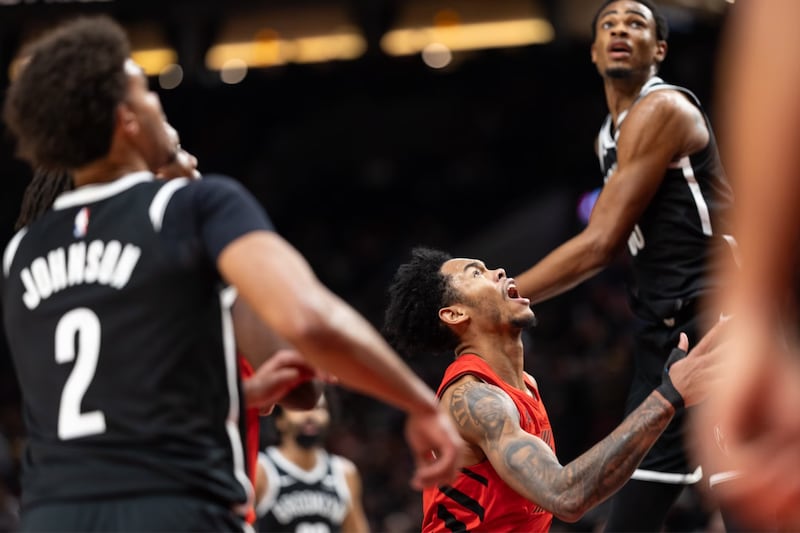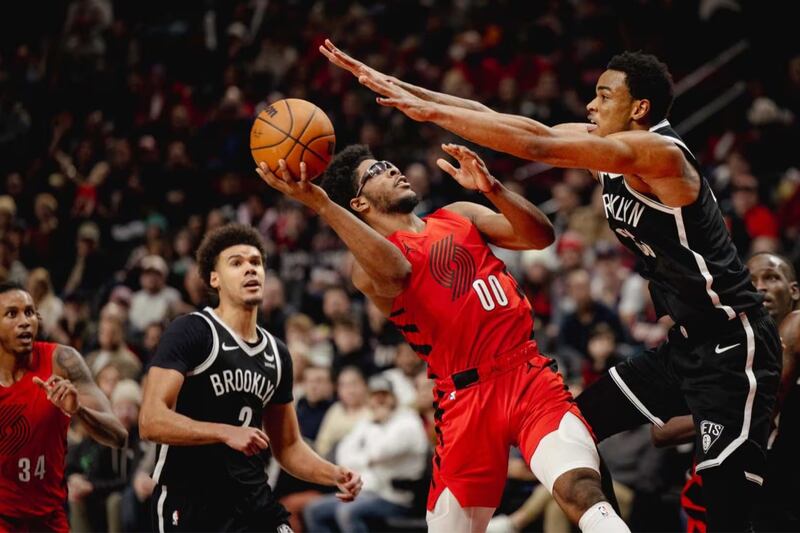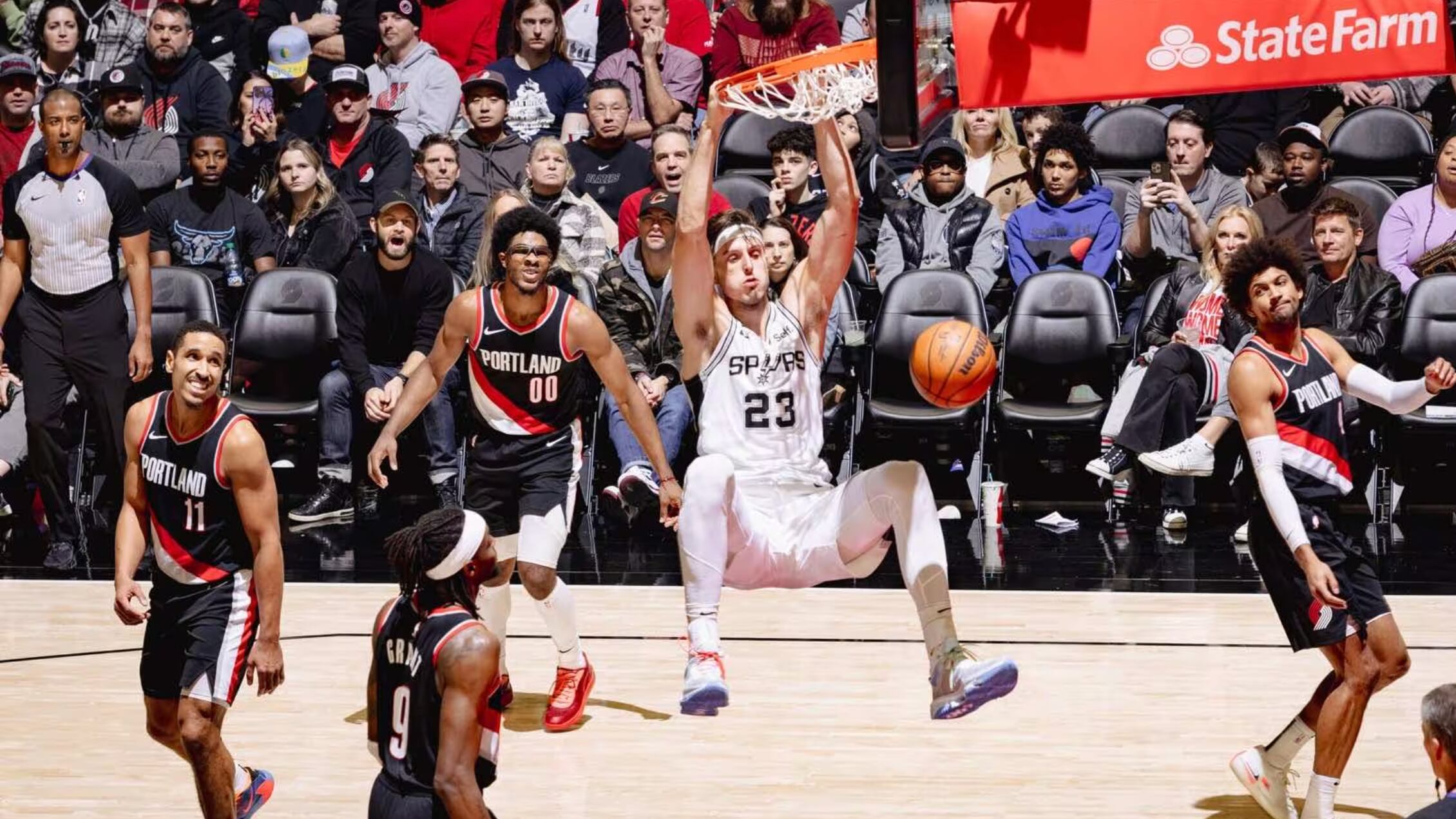For much of the season, driving on ice sounded more fun than watching the Portland Trail Blazers.
A recent seven-game road trip ended with a single victory and a 26-point average margin of defeat. The squad slid to a new low with a 62-point loss to the Oklahoma City Thunder. Everyone from independent beat reporter Sean Highkin to The Athletic’s John Hollinger seems downright bemused by the disastrous skid.
The Blazers looked about as listless and lethargic as the Detroit Pistons on a 28-game losing streak.
But fast forward a week and back-to-back victories over the Nets and Pacers had the Rose Garden rocking. The Blazers resurrected memories of a start to the season that promised feisty, competitive games and the possibility of playing spoiler on any given night. The whiplash has fans threatening to turn off the TV for good one night, and frantically scrolling for bargain tickets the next.
Now the question looms: Is a 26-point loss emblematic of a rudderless franchise? Or is the 12-29 midseason record just the icy patch of a long Oregon winter, and the car will straighten out?
Here’s the bigger problem: It’s not clear why the Blazers go through long stretches of sucking.
Unlike other clear NBA cellar dwellers, the Blazers jump-started a rebuild with two years of tanking. As we’ve discussed, to general manager Joe Cronin’s credit, there’s a cohesive philosophy undergirding the rebuild.
Deandre Ayton and Jerami Grant make sense as rangy and athletic starting big men. Scoot Henderson and Sharpe are touted as bona fide blue-chip prospects. Anfernee Simons has emerged as a legitimate offensive force. And Cronin snagged diamonds in the rough in Matisse Thybulle, Toumani Camara and Duop Reath. (All three were treated as trade throw-ins or cast-offs by past teams.)
The Blazers are fielding what should be the NBA’s equivalent of an Any Given Sunday roster. If everyone hits their potential, you can see a competitive starting five that could steal some wins against the league’s elite. Instead, they’re falling behind 36-15 after one quarter.
Two central questions are key to unraveling this mess.

What are they trying to do?
Head coach Chauncey Billups has constructed a basic defensive identity around playing aggressive, switch-everything defense that falls back on a zone as Plan B. In theory, hounding opponents like a 21st century Scottie Pippen makes sense. And we can see how Thybulle has thrived, picking opposing playmakers’ pockets at a remarkable clip:
Here's a look at who's been the most disruptive when it comes to generating turnovers
— BBall Index (@The_BBall_Index) January 10, 2024
⬆️More deflections and intercepted passes
➡️More on-ball steals pic.twitter.com/fTS111D8rT
On the other side of the ball, the offense has relied heavily on Grant and Simons isolations. That isn’t always a worst-case scenario. Simons is averaging 23 points on 38% shooting from deep and is still rounding into form as he recovers from missing 21 games to injury and illness. Grant’s footwork in the midrange has Kevin Calabro flashing back to the ’90s.
When all goes well, the Blazers play with frenetic energy, flying around on both ends of the court. Putback dunks and pestering defense abound.
We saw both in action on Wednesday night in an entertaining come-from-behind 105-103 victory over the woeful Brooklyn Nets. Grant scored 30 points in a flurry of midrange contorting buckets that would have made Kobe Bryant proud. The point-of-attack defense succeeded at forcing the Nets away from the center of the court into the teeth of help from the big men, leaving few passing angles for recovery. Simons capped a 13-point fourth quarter with a game-winning floater as time nearly expired.
The Blazers looked downright competent!
So that’s the Billups blueprint. But (far) more often than not, the game plan does not come together. The Blazers go through multigame stretches of lifeless play. They have the No. 23 defense in the NBA, surrendering 117 points per 100 possessions. At a certain point, it may be time to ask if Camara playing full-court press on a regular basis is the best means of setting up a halfcourt team defense. Or if having Henderson blitz every opposing point guard 35 feet from the hoop is a strategy that should be reserved for guarding Damian Lillard and Steph Curry. (Especially as he struggles with fouls.)
Say what you want about the tenets of a No. 23 defense, but at least it’s an ethos. Comparatively, the offense is abysmal. Avert-your-eyes abysmal. They are scoring an NBA-worst 107.1 points per 100 possessions as play stagnates—indeed, the Blazers are dead last in points created via assist and in the bottom third in average speed on offense. Neither of these stats are necessarily basketball deal breakers, but the Blazers did highlight increased assists and pace as preseason goals.
Malcolm Brogdon has been a steadying force on offense, offering veteran experience in reading defenses and initiating play-by-play offense. The Blazers are 8-6 when Brogdon plays 29 or more minutes, 3-14 when he plays fewer minutes. And 0-9 when he sits out.
But Brogdon is reportedly on the trade block. The league’s reigning Sixth Man of the Year doesn’t fit on a roster that has, for now, tied its long-term success to Simons, Sharpe, and Henderson. The offense is going to need to function with or without him.

Are these short-term hiccups or long-term problems?
One particularly bad stretch of play, or even a disastrous half season, is not a death sentence. Especially for a rebuilding team.
League history offers case studies for the optimistic. The Thunder lost a game by 73 points two years ago but now have the second-best record in the Western Conference as their young players gel. The 76ers won 47 games total over the course of three seasons during The Process years, but ultimately became a perennial playoff team. Our own Blazers suffered a 65-point loss in 1998 but made the conference finals the following year.
It also can’t be ignored that this is the second time in two years that we are discussing “things shouldn’t be this bad” and “nobody is making a leap.” The franchise needs some players to hit their best-case potential, as happened with basically the entire starting lineup for the 54-win 2013-14 roster.
If there is to be any hope, the Blazers must differentiate themselves from franchises churning their wheels in perpetual failed rebuilds. Portland deserves better than a west coast analogue to the Charlotte Hornets or Orlando Magic.
To make that happen, Henderson, Sharpe, and Billups must show signs of course correction. They have all been touted as the franchise’s future but have delivered mixed results.
In particular, Henderson’s uneven first-year campaign has become symbolic for his team’s fortunes. Overall, he hasn’t impressed. He’s averaging more than four turnovers and four fouls per 36 minutes while shooting below league average by every advanced metric. His shooting struggles around the rim are alarming for a player who was supposed to be cast in the stylistic mold of Russell Westbrook and Ja Morant.
Henderson needs to translate glimpses of promise into a bread-and-butter impact skill set. He continues to read defenses well and has used screens to hit his spots on the court. He is already a wizard at exploiting collapsing defenses to find open teammates for assists. The fouls on defense, as well as a continued willingness to take 3-pointers despite poor shooting, are good signs that Henderson has been willing to play through frustration.
As he continues adjusting to the speed of NBA basketball, his athleticism can be harnessed. Improved finishing at the rim, a continued solid assist rate, and eduction of nigh-unforgivable turnovers are all feasible goals in the short-term. (Editor’s note: Henderson left Friday’s game with a bruised nose. As of press time, his long-term prognosis has not been announced.)
In contrast to Henderson, Sharpe was hitting off-the-dribble stepback 3-pointers from game one. We have seen flashes of star potential—most recently, he scored 24 or more points in five consecutive games after Thanksgiving while shooting 20-for-43 on 3-pointers.
But Sharpe also isn’t a point guard so the ball doesn’t find his hands every possession. His skill set remains raw as he continues developing the countermoves necessary to outsmart an NBA defense. Combine that with a style that hues more toward a Brandon Roy-esque “pick your spots” patience, as opposed to Lillard-esque flamethrowing, and Sharpe can seemingly disappear for long stretches of games. For example, Sharpe’s usage rate and points per 100 possessions both take nose dives when he shares the court with a ball-dominant guard like Simons.
Sharpe is out for at least the next two weeks, but once he returns, fans should hope that more plays finish with the ball in his hands and he establishes himself as something more than a third option behind Grant and Simons.
Lastly, evaluating NBA coaches is notoriously difficult. It is fair to say, however, that the Blazers offense has been a failure. Injuries have hampered the rotation at times, but a team featuring Simons, Grant, Sharpe, Ayton and Brogdon has the firepower to be at least watchable on a quarter-by-quarter basis. And the Blazers should be good enough to differentiate themselves from the dreadful Hornets, Pistons, Spurs, and Wizards. As we saw on Wednesday, they can hold their own with mediocre teams like the Nets. That’s not saying much, but it’s better than what we have seen so far.
It feels fair to expect that Billups will be able to make adjustments that maximize the potential of Sharpe and his teammates, helping the Blazers slowly rise up the rankings on offense and finish with a net rating that rises above bottom-feeder status.
If improvement doesn’t happen over the back half of the season, the front office will need to evaluate why the team and players are not living up to their potential on a consistent basis. Cronin’s own version of The Process and Billups’ (defensive) vision seem solid on paper, but eventually that needs to translate to on-court results.
